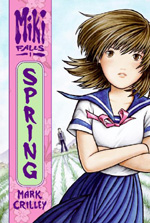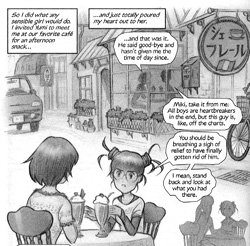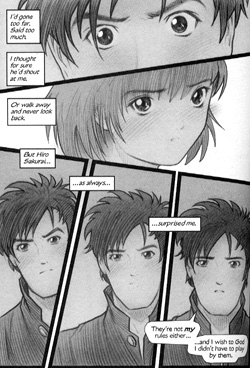 By Mark Crilley
By Mark Crilley
176 pages, black and white
Published by HarperTeen
Some might say that Mark Crilley’s been poised for success for over a decade now. His break-out comic series Akiko always showed those rare qualities in English-language comics that ultimately made Japanese imports so popular: a female protagonist, adventure, and a certain level of a delicate sensibility. His new series for HarperTeen, Miki Falls, takes that one step further—and while it may not have been his explicit goal, I can’t help but think that this book is probably the closest I’ve seen in a domestic release that fits seamlessly into the Japanese comic book culture while still maintaining the creator’s own unique voice.
Miki Yoshida’s final year of high school has begun, and she’s intrigued by Hiro Sakurai, the new boy in town. The problem is, Hiro wants nothing to do with Miki or in fact anyone else in their little town. Unfortunately for Hiro, Miki’s not going to take no for an answer. As she follows him around school and is determined to be his friend, though, she’s starting to realize that she may be in over her head. And when her fall happens, it could be a long one indeed.
 Miki Falls is structured as a four-volume series, each book taking place during one of the seasons over the course of a year. It’s very apt that the book begins in spring, then; as the world around Miki comes alive and begins to grow, so does her relationship with Hiro. It’s a very natural progression of events, perhaps because Crilley lets it unfold over several months, and in part because of his innate understanding of young women as characters. Miki’s actions, while a little extreme in places, also feel natural and unforced by the progression of plot. And while Miki and Hiro are really the only fleshed out characters, it’s nice to get reminders from time to time that Miki does have other friends in the form of people like Yumi, acting not only as a sounding board but as someone that Miki does participate in activities with. Crilley’s script gives Miki a well-rounded life, one that to English-speaking readers will seem familiar yet slightly foreign at the same time. Perhaps because Crilley never speaks down to the reader about the cultural differences between Japan and the rest of the world, any slight differences in her life feel somehow natural. (There’s no need for a footnote explaining exactly what onigiri is, but in the context it’s very clear that it’s a food product, by way of example.)
Miki Falls is structured as a four-volume series, each book taking place during one of the seasons over the course of a year. It’s very apt that the book begins in spring, then; as the world around Miki comes alive and begins to grow, so does her relationship with Hiro. It’s a very natural progression of events, perhaps because Crilley lets it unfold over several months, and in part because of his innate understanding of young women as characters. Miki’s actions, while a little extreme in places, also feel natural and unforced by the progression of plot. And while Miki and Hiro are really the only fleshed out characters, it’s nice to get reminders from time to time that Miki does have other friends in the form of people like Yumi, acting not only as a sounding board but as someone that Miki does participate in activities with. Crilley’s script gives Miki a well-rounded life, one that to English-speaking readers will seem familiar yet slightly foreign at the same time. Perhaps because Crilley never speaks down to the reader about the cultural differences between Japan and the rest of the world, any slight differences in her life feel somehow natural. (There’s no need for a footnote explaining exactly what onigiri is, but in the context it’s very clear that it’s a food product, by way of example.)
Best of all, though, is that Crilley’s conclusion to the first volume of Miki Falls takes this from a simple story about infatuation to something much bigger. It’s a very clever twist, the sort of thing that you can see a very long series being hung off of. The fact that Crilley’s story is confined to just four volumes makes it the more intriguing, because there’s very clearly a beginning, middle, and end to this particular idea in mind. While the book itself is told in flashback (opening up with a scene from the final volume), it’s much to Crilley’s credit that at the end of Miki Falls: Spring I wasn’t wondering about the opening cliffhanger set in the winter, but rather just what would happen in Miki Falls: Summer. This is the sort of story that you really do want to see unfold properly; there’s no jumping to the end desired when there’s so much fantastic middle waiting to be devoured.
 Crilley’s art has continued to refine itself over the years, and as much as I’ve liked his work on Akiko, Miki Falls is his best creation to date. Crilley draws his art here entirely in pencil, using gentle shades of gray to help give the world of Miki Falls a rich texture. Crilley seems especially fond of focusing in on character’s eyes, letting so much of their story be told through facial expressions and unspoken emotions. It’s a very soft, relaxing art style, one that does a great job of both looking very realistic while never seeming forced or posed. If anything, the reverse is true; these are characters who move and shift on the page with such ease that they almost feel fluid on the page.
Crilley’s art has continued to refine itself over the years, and as much as I’ve liked his work on Akiko, Miki Falls is his best creation to date. Crilley draws his art here entirely in pencil, using gentle shades of gray to help give the world of Miki Falls a rich texture. Crilley seems especially fond of focusing in on character’s eyes, letting so much of their story be told through facial expressions and unspoken emotions. It’s a very soft, relaxing art style, one that does a great job of both looking very realistic while never seeming forced or posed. If anything, the reverse is true; these are characters who move and shift on the page with such ease that they almost feel fluid on the page.
If I was to have a complaint about the art, it’s actually that I wish Crilley showed more of the backgrounds in the various scenes. When Crilley does draw the settings of Miki Falls, they’re beautiful, intriguing places. The school, the town, even the rice patties come across feeling lush and fully realized. And what can I say? I want more of it. As powerful as it may be to have lots of close-ups of characters as they react to each other, a small part of me wants an entire volume of Miki Falls to involve everyone going on wordless vacations around town. Perhaps to lots of restaurants followed by picnics? At any rate, when Crilley does draw the rest of the world of Miki Falls, they are—just like the story itself—pretty enchanting.
Miki Falls: Spring is a great introduction to Crilley’s new series. It’s been too long since the end of Akiko for more sequential art from Crilley (he’s been busy working on illustrated prose novels), and Miki Falls is a reminder of just how great Crilley’s comics are. The particular publishing imprint may be pushing this book at teenagers, but this is the sort of series that I think appeals to a much wider audience. This is a real joy from start to finish, and as said earlier, it has that certain sensibility that I think could really appeal to a lot of manga readers as well as a more typical Western audience. (The ones not looking for gigantic explosions, at any rate.) I, for one, am already planning on rushing out and buying Miki Falls: Summer. Once you’re done, I suspect you will want to as well. Highly recommended.
Purchase Links: Amazon.com
